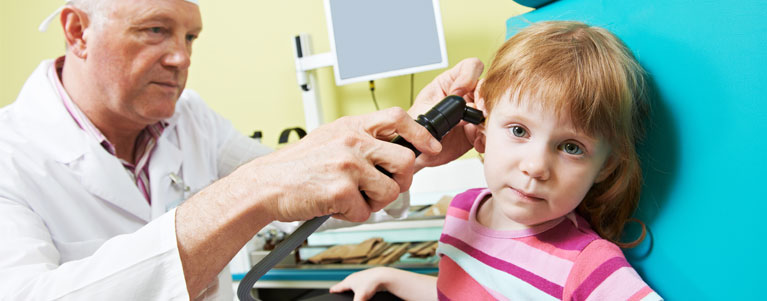EAR INFECTIONS IN CHILDREN
Otitis media, otherwise known as a middle ear infection, is the most frequent pediatric illness treated by otolaryngologists, occurring in three out of four children by the time they are three years old. A common ailment, an ear infection can be much more serious if it reaches nearby structures in the head, sometimes causing mastoiditis and/or meningitis. Because it affects parts of the ear that are crucial for hearing, otitis media can cause temporary hearing problems and, if left untreated, the hearing loss may become permanent. Hearing loss, particularly in children, can hinder learning capacity and even impede speech development. An ear infection can produce severe pain, causing serious distress for children. Fortunately, timely and effective treatment will almost always restore a child’s hearing and stop the pain.
TWO TYPES OF OTITIS MEDIA: ACUTE OTITIS MEDIA AND OTITIS MEDIA WITH EFFUSION
Acute otitis media most often occurs when a virus and/or bacteria enters the ear and causes an infection (usually from upper respiratory infections like the common cold or allergies). As a result, infected fluid (pus and mucus) accumulate behind the eardrum. Usually, the upper respiratory infection causes swelling and inflammation of the Eustachian tube and its surrounding tissues. The Eustachian tube is a tube that leads from the middle ear to the back of the nose and works to regulate pressure and drain mucus from the middle ear.
When normal Eustachian tube functioning is compromised, pressure and fluid buildup in the middle ear, creating pain, swelling, and redness. In severe or untreated cases, the eardrum ruptures, allowing pus to drain from the ear. More often, the pus and mucus remain in the middle ear for some time. If fluid remains in the middle ear several months after the infection has cleared, the condition is known as serous otitis media. Serous otitis media makes it more difficult to fight new infections, resulting in a frequent recurrence of acute otitis media. Also, because the fluid remains in the middle ear, serous otitis media further impairs the child’s hearing.
In severe cases of persistent infection and fluid build-up, further treatment may be required. This is most often a surgical procedure called myringotomy with tube placement. The procedure involves making a small opening in the eardrum and inserting tiny tubes that serve as a stent. The tubes relieve pressure and drain fluid from the middle ear.
The tubes stay in place for approximately ten months and then fall out on their own. The child can’t feel the tubes in the eardrum, and he or she will notice a significant relief of pressure and hearing improvement. In addition, a myringotomy with tube placement can decrease the frequency of ear infections.
For more information on chronic ear infections, read our latest blog post.

